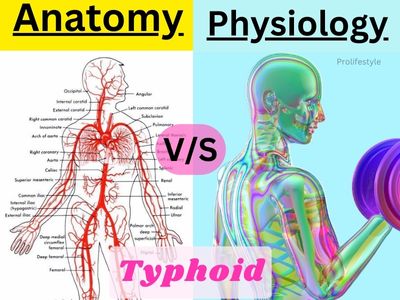Anatomy is the branch of biology that deals with the structure of organisms, including humans, animals, and plants. It focuses on the examination and description of the physical structures and components that make up living organisms, from the smallest cells to the largest organ systems.

Typhoid fever is a bacterial infection caused by the bacterium Salmonella enterica serotype Typhi (S. Typhi). It primarily affects the gastrointestinal system and can lead to systemic symptoms.
Here’s an overview of the anatomy of typhoid fever :
Causative Agent : Typhoid fever is caused by the bacterium Salmonella enterica serotype Typhi (S. Typhi). It is a Gram-negative, rod-shaped bacterium.
Route of Infection : Typhoid fever is typically contracted through the ingestion of contaminated food or water. The bacterium enters the body through the mouth and then makes its way to the intestines.
Systemic Symptoms : As the bacteria spread throughout the body, patients can develop systemic symptoms, including high fever, chills, weakness, headache, and muscle aches. The fever in typhoid fever can become very high and typically follows a characteristic pattern, known as a “step-ladder” fever curve.
Liver and Spleen Involvement : S. Typhi often accumulates in the liver and spleen, leading to hepatosplenomegaly (enlargement of these organs). This can cause discomfort and tenderness in the upper abdomen.
Diagnosis : Diagnosis of typhoid fever typically involves blood cultures to isolate the bacteria, as well as other laboratory tests to detect antibodies or specific antigens associated with the infection.
Treatment : Typhoid fever is usually treated with antibiotics, such as ciprofloxacin or azithromycin. Early treatment is essential to prevent complications.
📞 CALL NOW 📞 OR 📲 WHATSAPP NOW 📲
It’s important to note that typhoid fever is a serious illness that requires medical attention. Prompt diagnosis and treatment are crucial for a full recovery and to prevent the spread of the disease to others.
Typhi (S. Typhi), can have a significant impact on various physiological systems in the human body. The infection primarily affects the gastrointestinal system and can lead to systemic symptoms.
Here are some of the key PSYCHOLOGICAL effects of typhoid fever :
- Fever
- Weakness and Fatigue
- Headache and Muscle Aches
- Gastrointestinal Effects
- Malabsorption
- Hepatosplenomegaly
- Inflammatory Response
- Hepatosplenomegaly
- Tachycardia
- Hypotension
Here are some of the key ANATOMICAL effects of typhoid fever :
- Intestinal Inflammation
- Hepatosplenomegaly
- Gastrointestinal Bleeding
- Lymph Node Involvement
- Bone Marrow Anatomy
- Abscess Formation
- Neurological Complications
- Cardiovascular Effects
Psychological and Anatomical FAQ's
What is typhoid related anatomy and physiology ?
Typhoid fever is a bacterial infection caused by Salmonella enterica serotype Typhi (S. Typhi). The disease primarily affects the gastrointestinal system but can also have systemic effects. Here’s a summary of the anatomy and physiology related to typhoid fever :
📞 CALL NOW 📞 OR 📲 WHATSAPP NOW 📲
Anatomy :
- Intestinal Tract
- Liver and Spleen
- Lymphatic System
- Bone Marrow
- Central Nervous System
Physiology :
- Intestinal Inflammation
- Systemic Spread
- Immune Response
- Cardiovascular Effects
- Neurological Effects
What is the pathophysiology of the typhoid fever ?
The pathophysiology of typhoid fever refers to the sequence of events and physiological changes that occur in the body as a result of infection with the bacterium Salmonella enterica serotype Typhi (S. Typhi). Typhoid fever primarily affects the gastrointestinal system and can have systemic effects.
Here’s an overview of the pathophysiology of typhoid fever :
➡️ Infection and Entry :
- Infection typically occurs when contaminated food or water containing S. Typhi is ingested.
- The bacterium enters the body through the mouth and reaches the small intestine, particularly the ileum.
➡️ Attachment and Invasion :
- S. Typhi bacteria possess adhesion molecules that allow them to attach to the epithelial cells lining the intestinal mucosa.
- After attachment, the bacteria invade these cells by manipulating host cell processes.
➡️ Intracellular Survival :
- Once inside the host cells, S. Typhi can evade the immune system and antibiotics by residing within specialized compartments known as vacuoles.
- This intracellular survival is a key feature of S. Typhi’s pathophysiology.
➡️Gastrointestinal Effects :
- Invasion of the intestinal mucosa leads to inflammation and damage to the intestinal lining, resulting in:
- Abdominal pain and discomfort.
- Changes in bowel habits, including diarrhea or constipation.
- Malabsorption of nutrients due to disruption of the normal absorptive function of the intestines.
- Some S. Typhi bacteria can break free from infected intestinal cells and enter the bloodstream (bacteremia).
- The bacteremia marks the transition from localized gastrointestinal symptoms to systemic disease.
- The body’s immune system recognizes the presence of S. Typhi in the bloodstream and mounts an immune response.
- This response includes the production of antibodies and the activation of immune cells like macrophages to combat the infection.
- Chills.
- Weakness and fatigue.
- Headache.
- Muscle aches.
- S. Typhi can accumulate in the liver and spleen, leading to the enlargement of these organs (hepatosplenomegaly).
- This can result in abdominal tenderness and discomfort.
What is the structure of typhoid fever ?
Typhoid fever is not a structure but a disease caused by the bacterium Salmonella enterica serotype Typhi (S. Typhi). It is important to clarify that typhoid fever is an infectious disease, and its causative agent, S. Typhi, is a bacterium with a specific structure.
Here is an overview of the structure of S. Typhi ( salmonella typhoid) :
➡️ Bacterial Classification :
S. Typhi is a member of the genus Salmonella, which belongs to the family Enterobacteriaceae. It is a Gram-negative bacterium.
➡️ Cell Shape :
S. Typhi is typically rod-shaped (bacillus) and is approximately 1-2 micrometers in length.
➡️Cell Envelope :
- Cell Membrane : Like all Gram-negative bacteria, S. Typhi has an inner cell membrane.
- Cell Wall : It possesses a thin peptidoglycan cell wall, which is sandwiched between the inner and outer membranes.
- Outer Membrane : The outer membrane of S. Typhi contains lipopolysaccharides (LPS), which are important for its pathogenicity. LPS is an endotoxin that can trigger an immune response in the host.
➡️ Genetic Material :
S. Typhi, like all bacteria, contains genetic material in the form of a single, circular DNA molecule located in the bacterial cell’s cytoplasm. It also has plasmids, which are smaller, circular pieces of DNA that can carry additional genes.
➡️ Metabolism :
S. Typhi is a facultative anaerobe, meaning it can grow both in the presence and absence of oxygen. It is capable of fermenting sugars and using them as an energy source.
What is the function of the typhoid fever ?
Typhoid fever is not a functional entity or organ in the body; rather, it is a disease caused by the bacterium Salmonella enterica serotype Typhi (S. Typhi). Therefore, it does not have a specific function in the body. Instead, the focus should be on the functions of the bacterium and the effects it has on the human body when it causes the disease.
Here’s an overview of the function of typhoid fever :
➡️ Bacterial Function (S. Typhi) :
- S. Typhi is a pathogenic bacterium that causes typhoid fever.
- Its primary function, from a biological perspective, is to replicate and survive within a host organism, which in this case is a human.
➡️ Effects on the Human Body (Pathophysiology) :
- When S. Typhi infects a human host, it can invade the intestinal mucosa, particularly in the ileum (a part of the small intestine).
- The bacterium damages the host’s intestinal cells and can cause inflammation of the intestinal lining.
- S. Typhi can spread from the intestines to other parts of the body through the bloodstream, leading to systemic symptoms and complications.
➡️ Clinical Manifestations :
The primary function of S. Typhi, in the context of typhoid fever, is to cause a range of symptoms and physiological changes in the infected individual.
These can include :
- High fever
- Gastrointestinal symptoms (abdominal pain, diarrhea, constipation)
- Weakness
- Headache
- Muscle aches
- Enlargement of the liver and spleen (hepatosplenomegaly)
- Potential complications such as intestinal perforation, gastrointestinal bleeding, and abscess formation.
Which part of the body is affected by typhoid ?
Typhoid fever primarily affects the gastrointestinal system and can have systemic effects on various organs and tissues in the body.
Here are the main parts of the body that are affected by typhoid fever :
➡️ Small Intestine (Ileum) :
The initial and primary site of infection by the bacterium Salmonella enterica serotype Typhi (S. Typhi) is the small intestine, particularly the ileum, which is the last part of the small intestine. S. Typhi invades the intestinal mucosa, leading to inflammation and damage to the intestinal lining.
➡️ Liver :
S. Typhi can accumulate in the liver, leading to hepatosplenomegaly, which is the enlargement of the liver. This can result in abdominal tenderness and discomfort.
➡️ Spleen :
Similar to the liver, S. Typhi can accumulate in the spleen, leading to hepatosplenomegaly. Enlargement of the spleen can also cause discomfort in the upper left side of the abdomen.
➡️ Bloodstream :
As the infection progresses, S. Typhi can enter the bloodstream (bacteremia). This marks the transition from localized gastrointestinal symptoms to systemic disease
➡️ Central Nervous System (Rarely) :
In exceptionally rare cases, S. Typhi can invade the central nervous system, potentially leading to neurological complications such as meningitis or encephalitis.


